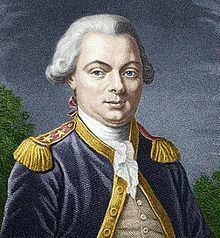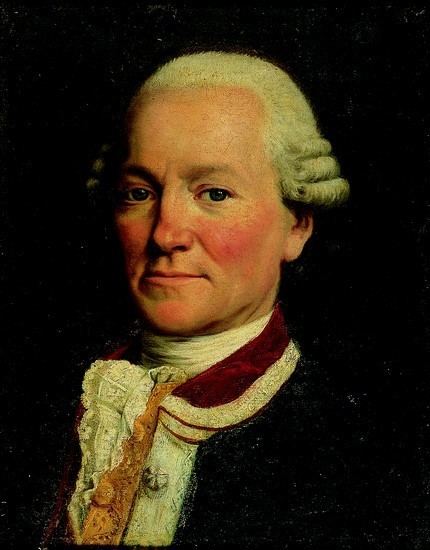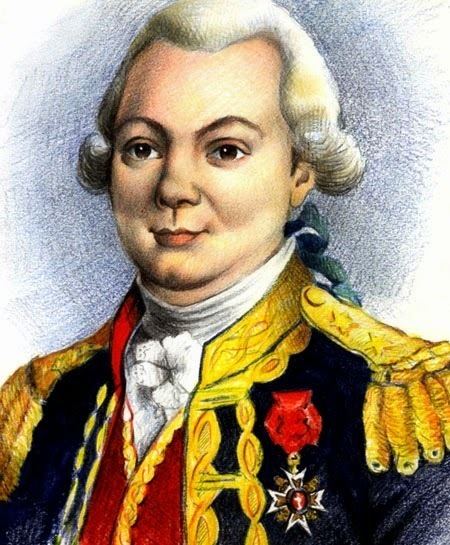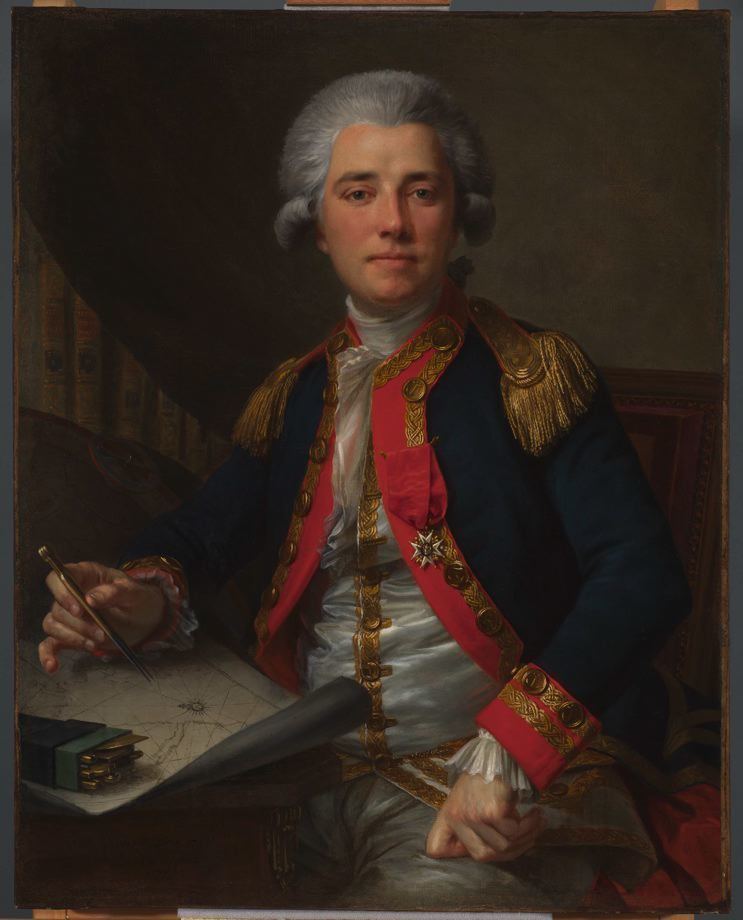Awards Order of Saint Louis Role Naval Officer | Name Jean-Francois Galaup, Years of service 1756–1788 | |
 | ||
Rank CommodoreChef d\'escadrecontemporary equivalencyRear Admiral or Counter Admiral Commands held Amazone,Astree,Boussole Battles/wars Seven Years\' WarBattle of Quiberon BayAmerican Revolutionary WarNaval battle of Louisbourg Books Life in a California Mission: Monterey in 1786: The Journals of Jean Francois de la Perouse Parents Marguerite de Resseguier, Victor-Joseph de Galaup Battles and wars Seven Years\' War, Battle of Quiberon Bay, American Revolutionary War, Action of 21 July 1781 Similar People James Cook, Samuel Hearne, Louis‑Rene Levassor de Latouc | ||
Jean François de Galaup, comte de Lapérouse ([ʒɑ̃ fʁɑ̃swa də ɡalop kɔ̃t də lapeʁuːz]; variant spelling of his name comte "de La Pérouse"; 23 August 1741 – 1788?) was a French Naval officer and explorer whose expedition vanished in Oceania.
Contents
Early career

Jean-François de Galaup was born near Albi, France. Lapérouse was the name of a family property that he added to his name. He studied in a Jesuit college and entered the naval college in Brest when he was fifteen. In 1757 he was posted to the Célèbre and participated in a supply expedition to the fort of Louisbourg in New France. Lapérouse also took part in a second supply expedition in 1758 to Louisbourg, but as this was in the early years of the Seven Years' War, the fort was under siege and the expedition was forced to make a circuitous route around Newfoundland to avoid British patrols.

In 1759, Lapérouse was wounded in the Battle of Quiberon Bay, where he was serving aboard the Formidable. He was captured and briefly imprisoned before being paroled back to France; he was formally exchanged in December 1760. He participated in a 1762 attempt by the French to gain control of Newfoundland, escaping with the fleet when the British arrived in force to drive them out.
Following the Franco-American alliance, Lapérouse fought against the Royal Navy off the American coast, and victoriously led the frigate L'Astrée in the Naval battle of Louisbourg, 21 July 1781. He was promoted to the rank of commodore when he defeated the English frigate Ariel in the West Indies. He then escorted a convoy to the West Indies in December 1781, participated in the attack on St. Kitts in February 1782 and then fought in the defeat at the Battle of the Saintes against the squadron of Admiral Rodney. In August 1782 he made his name by capturing two English forts (Prince of Wales Fort and York Fort) on the coast of Hudson Bay, but allowed the survivors, including Governor Samuel Hearne of Prince of Wales Fort, to sail off to England in exchange for a promise to release French prisoners held in England. The next year, his family finally consented to his marriage to Louise-Eléonore Broudou, a young creole of modest origins whom he had met on Île de France (present-day Mauritius) eight years earlier.
Objectives
Lapérouse was appointed in 1785 by Louis XVI and by the Secretary of State of the Navy, the Marquis de Castries, to lead an expedition around the world. Many countries were initiating voyages of scientific explorations.

Louis XVI and his court had been stimulated by a proposal from the Dutch-born merchant adventurer William Bolts, who had earlier tried unsuccessfully to interest Louis’s brother-in-law, the Holy Roman Emperor Joseph II (brother of Queen Marie Antoinette), in a similar voyage. The French court adopted the concept (though not its author, Bolts), leading to the dispatch of the Lapérouse expedition. Charles Pierre Claret de Fleurieu, Director of Ports and Arsenals, stated in the draft memorandum on the expedition that he submitted to the Louis XVI: "the utility which may result from a voyage of discovery ... has made me receptive to the views put to me by Mr. Bolts relative to this enterprise". But Fleurieu explained to the King: "I am not proposing at all, however, the plan for this voyage as it was conceived by Mr. Bolts".
The expedition's aims were to complete the Pacific discoveries of James Cook (whom Lapérouse greatly admired), correct and complete maps of the area, establish trade contacts, open new maritime routes and enrich French science and scientific collections. His ships were the L'Astrolabe (under Fleuriot de Langle) and the La Boussole, both 500 tons. They were storeships reclassified as frigates for the occasion. Their objectives were geographic, scientific, ethnological, economic (looking for opportunities for whaling or fur trading), and political (the eventual establishment of French bases or colonial cooperation with their Spanish allies in the Philippines). They were to explore both the north and south Pacific, including the coasts of the Far East and of Australia, and send back reports through existing European outposts in the Pacific.
Preparations
As early as March 1785, Lapérouse proposed that Paul Monneron, who had been chosen as the expedition's chief engineer, go to London to find out about the anti-scurvy measures recommended by Cook and the exchange items used by Cook in his dealings with native peoples, and to buy scientific instruments of English manufacture.
The best-known figure from Cook's missions, Joseph Banks, intervened at the Royal Society to obtain for Monneron two inclining compasses that had belonged to Cook. Furnished with a list produced by Charles Pierre Claret de Fleurieu, Monneron also bought scientific instruments from some of the largest English firms, particularly Ramsden. He even surpassed Fleurieu's directives by acquiring two sextants of a new type.
Crew
Lapérouse was well liked by his men. Among his 114-man crew there were ten scientists: Joseph Lepaute Dagelet (1751–1788), an astronomer and mathematician; Robert de Lamanon, a geologist; La Martinière, a botanist; a physicist; three naturalists; and three illustrators, Gaspard Duché de Vancy and an uncle and nephew named Prévost. Another of the scientists was Jean-André Mongez. Even both chaplains were scientifically schooled.
One of the men who applied for the voyage was a 16-year-old Corsican named Napoléon Bonaparte. Bonaparte, a second lieutenant from Paris's military academy at the time, made the preliminary list but he was ultimately not chosen for the voyage list and remained behind in France. At the time, Bonaparte was interested in serving in the navy rather than army because of his proficiency in mathematics and artillery, both valued skills on warships.
Copying the work methods of Cook's scientists, the scientists on this voyage would base their calculations of longitude on precision watches and the distance between the moon and the sun followed by theodolite triangulations or bearings taken from the ship, the same as those taken by Cook to produce his maps of the Pacific islands. As regards geography, Lapérouse decisively showed the rigour and safety of the methods proven by Cook. From his voyage, the resolution of the problem of longitude was evident and mapping attained a scientific precision. Impeded (as Cook had been) by the continual mists enveloping the northwestern coast of America, he did not succeed any better in producing complete maps, though he managed to fill in some of the gaps.
Chile and Hawaii
Lapérouse and his 220 men left Brest on 1 August 1785, rounded Cape Horn, investigated the Spanish colonial government in the Captaincy General of Chile. He arrived on 9 April 1786 at Easter Island He then sailed to the Sandwich Islands, the present-day Hawaiian Islands, where he became the first European to set foot on the island of Maui.
Alaska
Lapérouse sailed on to Alaska, where he landed near Mount St. Elias in late June 1786 and explored the environs. On 13 July 1786 a barge and two longboats, carrying 21 men, were lost in the heavy currents of the bay called Port des Français by Lapérouse, but now known as Lituya Bay. The men visited with the Tlingit tribe. (This encounter was dramatized briefly in episode 13 of Carl Sagan's Cosmos: A Personal Voyage.) Next, he headed south, exploring the northwest coast, including the outer islands of present-day British Columbia
California
Lapérouse sailed between 10–30 August all the way south to the Spanish Las Californias Province, present-day California. He reportedly observed the only historical eruption of Mount Shasta on 7 September 1786, although this account is disputed. He stopped at the Presidio of San Francisco long enough to create an outline map of the Bay Area, Plan du port de St. François, situé sur la côte de la Californie septentrionale ("Map of the port of San Francisco, situated on the coast of Northern California"), which was reproduced as Map 33 in L. Aubert's 1797 Atlas du voyage de La Pérouse. He arrived in Monterey Bay and at the Presidio of Monterey on 14 September 1786. He examined the Spanish settlements, ranchos, and missions. He made critical notes on the missionary treatment of the California indigenous peoples with the Indian Reductions at the Franciscan run missions. France and Spain were on friendly terms at this time. Lapérouse was the first non-Spanish visitor to California since Drake in 1579, and the first to come to California after the founding of Spanish missions and presidios (military forts).
East Asia
Lapérouse again crossed the Pacific Ocean in 100 days, arriving at Macau, where he sold the furs acquired in Alaska, dividing the profits among his men. The next year, on 9 April 1787, after a visit to Manila, he set out for the northeast Asian coasts. He saw the island of Quelpart, in the Korean Peninsula, (present-day Cheju in South Korea), which had been visited by Europeans only once before when a group of Dutchmen shipwrecked there in 1635. He visited the Asian mainland coasts of Korea.
Japan and Russia
Lapérouse then sailed northward to Northeast Asia and Oku-Yeso Island, present day Sakhalin Island, Russia. The Ainu people, Oku-Yeso Island residents, drew him a map showing: their second domain of Yezo Island, present day Hokkaidō Island, Japan; and the coasts of Tartary, Russia on mainland Asia. Lapérouse wanted to sail north through the narrow Strait of Tartary between Oku-Yeso Island and mainland Asia, but failed. Instead, he turned south, and then sailed west through La Pérouse Strait, between Oku-Yeso Island (Sakhalin) and (Hokkaidō), where he met more Ainu in their third domain of the Kuril Islands, and explored.
Lapérouse then sailed north and reached Petropavlovsk on the Russian Kamchatka peninsula on 7 September 1787. Here they rested from their trip, and enjoyed the hospitality of the Russians and Kamchatkans. In letters received from Paris, Lapérouse was ordered to investigate the settlement the British were establishing in New South Wales, Australia. Barthélemy de Lesseps, the French vice consul at Kronstadt, Russia, who had joined the expedition as an interpreter, disembarked in Petropavlovsk to bring the expedition's ships' logs, charts, and letters to France, which he reached after a year-long, epic journey across Siberia and Russia.
South Pacific
Lapérouse next stopped in the Navigator Islands (Samoa), on 6 December 1787. Just before he left, the Samoans attacked a group of his men, killing twelve, among whom were Lamanon and de Langle, commander of L'Astrolabe. Twenty men were wounded. The expedition drifted to Tonga, for resupply and help, and later recognized the île Plistard and Norfolk Island.
Australia
The expedition continued to Australia, arriving off Botany Bay on 24 January 1788, just as Captain Arthur Phillip was attempting to move the colony from there to Sydney Cove in Port Jackson. The First Fleet was unable to leave until 26 January because of a tremendous gale, which also prevented Lapérouse's ships from entering Botany Bay.
The British received him courteously, and each captain, through their officers, offered the other assistance and needed supplies. Lapérouse spent 6 weeks in the colony and this was his last recorded landfall. The French established an observatory, held Catholic masses, made geological observations, and established a garden. Their chaplain from L'Astrolabe was buried there and is celebrated annually on the anniversary of his death. Although Phillip and Lapérouse did not meet, there were 11 visits recorded between the French and the English. Over the past 200 years, commanders from the French Navy have regularly paid their respects at the Lapérouse Monument. Lapérouse Day, Bastille Day and the foundation of the Lapérouse Monument by Hyacinthe de Bougainville are celebrated every year.
Lapérouse took the opportunity to send his journals, some charts and also some letters back to Europe with a British naval ship from the First Fleet—the Alexander. He also obtained wood and fresh water and, on 10 March, left for New Caledonia, Santa Cruz, the Solomons, the Louisiades, and the western and southern coasts of Australia.
Lapérouse wrote that he expected to be back in France by June 1789. The documents that he dispatched with the Alexander from the in-progress expedition were brought to Paris, where they were published in 1797 under the title Voyage de La Pérouse. However, neither he nor any of his men were seen again.
HMS Pandora
Reportedly HMS Pandora missed a chance to rescue the survivors in May 1791. See the discussion below in section "The saga".
Rescue mission of d'Entrecasteaux
On 25 September 1791, Rear Admiral Bruni d'Entrecasteaux departed Brest in search of Lapérouse. His expedition followed Lapérouse's proposed path through the islands northwest of Australia while at the same time making scientific and geographic discoveries. The expedition consisted of two ships, La Recherche and L'Espérance.
In May 1793, he arrived at the island of Vanikoro, which is part of the Santa Cruz group of islands (now part of the Solomon Islands). D'Entrecasteaux thought he saw smoke signals from several elevated areas on the island, but was unable to investigate due to the dangerous reefs surrounding the island and had to leave. He died two months later. The botanist Jacques Labillardière, attached to the expedition, eventually returned to France and published his account, Relation du voyage à la recherche de La Pérouse, in 1800.
During the French Revolution, Franco-British relations deteriorated and unfounded rumours spread in France blaming the British for the tragedy which had occurred in the vicinity of the new colony. Before the mystery was solved, the French government had published the records of the voyage as far as Kamchatka: Voyage de La Pérouse autour du monde, 1–4 (Paris, 1797). These volumes are still used for cartographic and scientific information about the Pacific. Three English translations were published in 1798–99.
1826 expedition
It was not until 1826 that an Irish sea captain, Peter Dillon, found enough evidence to piece together the events of the tragedy. In Tikopia (one of the islands of Santa Cruz), he bought some swords that he had reason to believe had belonged to Lapérouse or his officers. He made enquiries, and found that they came from nearby Vanikoro, where two big ships had broken up years earlier. Dillon managed to obtain a ship in Bengal, and sailed for the coral atoll of Vanikoro where he found cannonballs, anchors and other evidence of the remains of ships in water between coral reefs.
He brought several of these artifacts back to Europe, as did Dumont d'Urville in 1828. De Lesseps, the only member of the original expedition still alive at the time, identified them as all belonging to L'Astrolabe. From the information Vanikoro inhabitants gave Dillon, a rough reconstruction could be made of the disaster that struck Lapérouse. Dillon's reconstruction was later confirmed by the discovery, and subsequent examination in 1964, of what was believed to be the shipwreck of La Boussole.
2005 expedition
In May 2005, the shipwreck examined in 1964 was formally identified as that of La Boussole. The 2005 expedition had embarked aboard the Jacques Cartier, a vessel of the French Navy. The ship supported a multi-discipline scientific team assembled to investigate the "Mystery of Lapérouse". The mission was called "Opération Vanikoro - Sur les traces des épaves de Lapérouse 2005".
2008 expedition
A further similar mission was mounted in 2008.
The 2008 expedition showed the commitment of France, in conjunction with the New Caledonian Association Salomon, to seek further answers about Lapérouse's mysterious fate. It received the patronage of the President of the French Republic as well as the support and co-operation of the French Ministry of Defense, the Ministry of Higher Education and Research, and the Ministry of Culture and Communication.
Preparation for this, the eighth expedition sent to Vanikoro, took 24 months. It brought together more technological resources than previously and involved two ships, 52 crew members and almost 30 scientists and researchers. On 16 September 2008, two French Navy boats set out for Vanikoro from Nouméa (New Caledonia), and arrived on 15 October, thus recreating a section of the final voyage of discovery undertaken more than 200 years earlier by Lapérouse.
The saga
Both ships had been wrecked on Vanikoro's reefs, the La Boussole first. The L'Astrolabe was unloaded and taken apart. A group of men, probably the survivors of La Boussole, was massacred by the local inhabitants. According to the islanders, some surviving sailors built a two-masted craft from the wreckage of the L'Astrolabe and left in a westward direction about nine months later; but what happened to them is unknown. Also, two men, one a "chief" and the other his servant, had remained behind, but had left Vanikoro a few years before Dillon arrived.
Sven Wahlroos, in his 1989 book, Mutiny and Romance in the South Seas, suggests that there was a narrowly missed chance to rescue one or more of the survivors in 1791.
In November 1790, Captain Edward Edwards—in command of HMS Pandora—had sailed from England with orders to comb the Pacific for the mutineers of HMS Bounty. In March of the following year, the Pandora arrived at Tahiti and picked up 14 Bounty men who had stayed on that island. Although some of the 14 had not joined the mutiny, all were imprisoned and shackled in a cramped "cage" built on the deck, which the men grimly nicknamed "Pandora's Box". The Pandora then left Tahiti in search of the Bounty and the leader of the mutiny, Fletcher Christian.
Captain Edwards' search for the remaining mutineers ultimately proved fruitless. However, when passing Vanikoro on 13 August 1791, smoke signals were observed rising from the island. Edwards, single-minded in his search for the Bounty and convinced that mutineers fearful of discovery would not be advertising their whereabouts, ignored the smoke signals and sailed on.
Wahlroos argues that the smoke signals were almost certainly a distress message sent by survivors of the Lapérouse expedition, which later evidence indicated were still alive on Vanikoro at that time—three years after the La Boussole and L'Astrolabe had foundered. Wahlroos is "virtually certain" that Captain Edwards, whom he characterizes as one of England's most "ruthless," "inhuman," "callous" and "incompetent" naval captains, missed his chance to become "one of the heroes of maritime history" by solving the mystery of the lost Lapérouse expedition.
Legacy
Places later named in honour of Lapérouse include:
Several ships have also been named after him:
Lapérouse in literature and film
The fate of Lapérouse, his ships and his men is the subject of a chapter from Twenty Thousand Leagues Under the Sea by Jules Verne. Lapérouse was also mentioned in an episode ("The Quest") of the series Northern Exposure where the character Joel (Rob Morrow) finds an old chart of the French explorer that will lead to a legendary "jewelled city of the North" (New York).
The novel "Landfalls" by Naomi J. Williams explores the Lapérouse expedition in depth.
